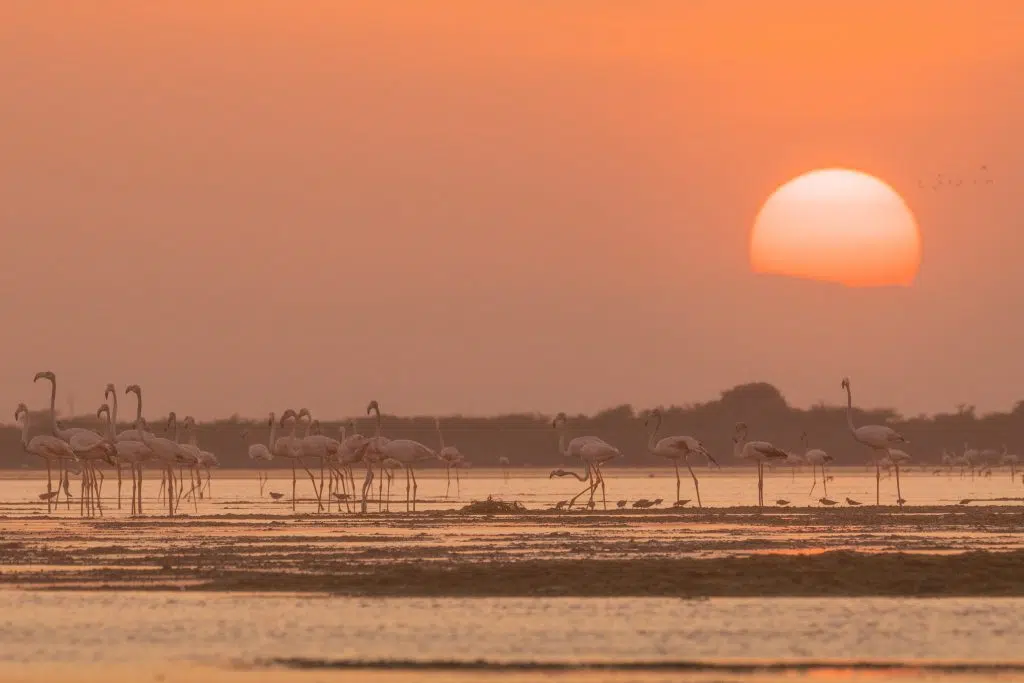Flamingo Deaths Highlight Development Tensions

This migration season has been particularly deadly for migrating flamingos in India, and these collisions are highlighting the ever-increasing tensions between human development and wildlife.
By Ariana Loehr
With glorious pink wings spread wide, and gangly legs trailing behind, the migration of flamingos should be nothing but spectacular. Yet, this vision could not be farther from the truth. With a sharp jolt and a thud, flamingos hit the ground, lifeless, after unexpected collisions with powerlines, cars and airplanes near the wintering wetlands in India. These unconventional birds who have captured our imagination with their vibrant feathers and quirky mannerisms, deserve freedom to fly without harm across landscapes we both share.
Every winter, flocks of Greater and Lesser Flamingos descend upon wetlands in Southern India. They stay in the area, feeding on algae, microorganisms or small crustaceans, from the months of November through May. Between May and July, the flamingos begin their migration journey back to their breeding grounds in the North of the county and across nearby borders.
One place that is known for its flocks of flamingos is Thane Creek Flamingo Sanctuary near Mumbai, a city of over 20 million people. The numbers of flamingos in this sanctuary have increased year on year, and it’s believed that humans have something to do with this. As urban runoff enters wetlands, it creates a proliferation of algae, which is exactly what flamingos like to eat.

The birds’ winter visits are a welcome sight for people in Mumbai. During the wintering season, Bombay Natural History Society (BirdLife in India) regularly takes groups of birdwatchers on visits around Thane Creek to observe and count the flamingos. However, while it is fantastic to have such beautiful and intriguing birds so easily visible to large numbers of people in a major metropolitan area, their proximity to the city is risky.
Not only do roads circle the sanctuary, and powerlines criss-cross the sky, but one of the busiest airports in India is just 20 kilometres away. All of these pose collision risks as we’ve seen this year, with a car crash and even a low flying plane wiping out 39 individuals from a flock. Further south in Karnataka, flamingos in flight have died from direct collisions with powerlines themselves.

Despite these heartbreaking incidents, this isn’t a story about the evils of human development.
Infrastructure expansion around the globe is incredibly important. Expanded road networks carry vital foods and medicines, and powerlines provide knowledge and life-saving electricity to a growing population. India already has been a leader in renewable energy, utilising some of its greatest natural resources to provide 42% of the country’s energy. For that number to grow, the grid will need to expand, and quickly.
A flock of 39 Lesser Flamingos were struck by a passenger aircraft over the Ghatkopar area in Mumbai on 21st May. Other large bird species including Cranes, Vultures, and GIBs also died in various parts of India due to electrocution or collisions. BNHS is engaged in sensitivity mapping for birds and also providing IT tools to agencies for preventing deaths.
Kishor Rithe
Director, BNHS
The expansion of renewable energy clearly aims to decrease the levels of carbon in the atmosphere. In aiming for that goal, we mustn’t lose sight of how wildlife also helps to lower the carbon footprint. Birds and other wildlife across the globe help to maintain existing carbon capturing ecosystems by pollinating plants, spreading seeds, decomposing, or in the case of the flamingos in Thane Creek, eating algae that might otherwise lead to eutrophication and fish die-offs. Thus, if developments such as renewable energy infrastructure don’t take wildlife into consideration- we risk releasing additional stores of carbon into the atmosphere.
So, is it possible for development to continue without harm to birds and other wildlife? Let’s look at possible solutions. Around the world bird diverters are being used to prevent collisions with existing powerlines. Going forward, AviStep, an open-source tool for energy planning, can help to avoid renewable energy infrastructure from being developed in areas that are sensitive sites for birds. The tool can also help determine where it might be beneficial to bury powerlines. Signage that signals for wildlife crossings and decreased speed limits can put the brakes on road accidents with large birds, as can wildlife crossings above and below roads. While, preventing bird strikes with planes will require a great amount of coordination between aviation officials, pilots and people on the ground.
All these possible fixes allow for future flocks of flamingos to remain in the sky and for positive development to continue. It’s a very delicate balance to get right, but worth trying, to ensure that both communities and the wildlife that surrounds them, have a healthy planet where they can thrive.
